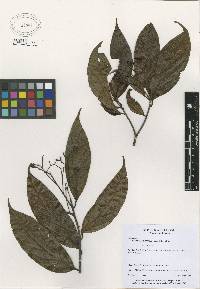

|
|
|
|
Family: Lauraceae
Sigua, more...sigua negro
[Nectandra purpurascens (Ruiz & Pav.) Mez, moreNectandra purpurea (Ruiz & Pav.) Mez] |
Descripción: Árbol de 5 a 15 m de alto. Ramitas terminales cilíndricas. Tronco con pequeñas raíces fúlcreas en la base. Corteza exterior negra o marrón. Hojas simples y alternas, de 10-25 x 5-10 cm, elípticas, con ápice acuminado, bordes enteros y base obtusa. Las hojas presentan grupos de pelos en las axilas de las nervaduras del envés, cuando jóvenes las hojas son rojas y ligeramente moradas. Pecíolo de 0.5-1.5 cm de largo. Flores blancas y aromáticas. Frutos en drupas globosas, de 1.5-2.5 cm de largo, verdes, tornándose negros y con una copa basal roja al madurar. Datos Ecológicos: La especie crece a bajas y medianas elevaciones, en bosques húmedos o muy húmedos. En Panamá se encuentra en las provincias de Bocas del Toro, Chiriquí, Coclé, Colón, Darién, Panamá y la comarca Guna Yala. Florece y fructifica de mayo a septiembre. Las flores son visitadas por abejas y otros insectos. Las semillas son dispersadas por animales, principalmente aves que se alimentan de los frutos maduros. Especies Parecidas: A menudo se confunde con LK nectgl Nectandra lineata LK2 , pero en Nectandra lineata las hojas tienen un par de apéndices auriculares en la base. Usos: La madera es empleada en construcciones locales, postes de cercas y mangos de herramientas. Small tree, to 17 m tall and 27 cm dbh, glabrous except young parts with short appressed trichomes. Petioles 1-1.5 cm long, slightly canaliculate; blades ovate to elliptic or lanceolate-elliptic, long-acuminate and sometimes falcate at apex, acute to rounded at base, 6-20 cm long, 3-6 cm wide, usually bearing weak tufts of trichomes (domatia) in lower vein axils on underside of leaves; midrib arched, the reticulate venation conspicuous on both surfaces. Panicles 6-12 cm long, terminal or in upper axils; flowers bisexual, white, ca 5 mm wide, with sweet aroma, in usually subcorymbiform panicles; perianth lobes 6, fleshy, spreading, densely short-pubescent, the inner 3 usually narrower; stamens exserted, the outer 6 with short filaments and the anthers +/- reniform, the glands white or orange, subtending and alternating with outer stamens (often larger than anthers), the 3 inner stamens closely surrounding and +/- equaling the length of the style, alternating with 3 shorter staminodia; ovary glabrous. Fruits fleshy, 1-seeded, +/- rounded, green and speckled, becoming black at maturity, to 1.5 cm diam, the pedicel and cupule conical, bright red, together ca 1 cm long. Croat 9556. Frequent along the shore, especially on the north side of the island; occasional in the younger forest. Some flowers may be seen in all months of the year, but flowering occurs principally in two waves, one at the beginning of the dry season (December to March) and one at the beginning of the rainy season (May to July). The fruits usually develop within a few months, but some have been seen as late as October. Individual plants flowering in March were seen again with both flowers and fruits in the rainy season. Standley mistakenly reported this species as N. glabrescens Benth., which has affinities with N. globosa and occurs in Panama only along the Atlantic slope. Bocas Species Database Distribution: Islas Popa y Colon Characteristics: Shrub, Tree |
|
|
|


















